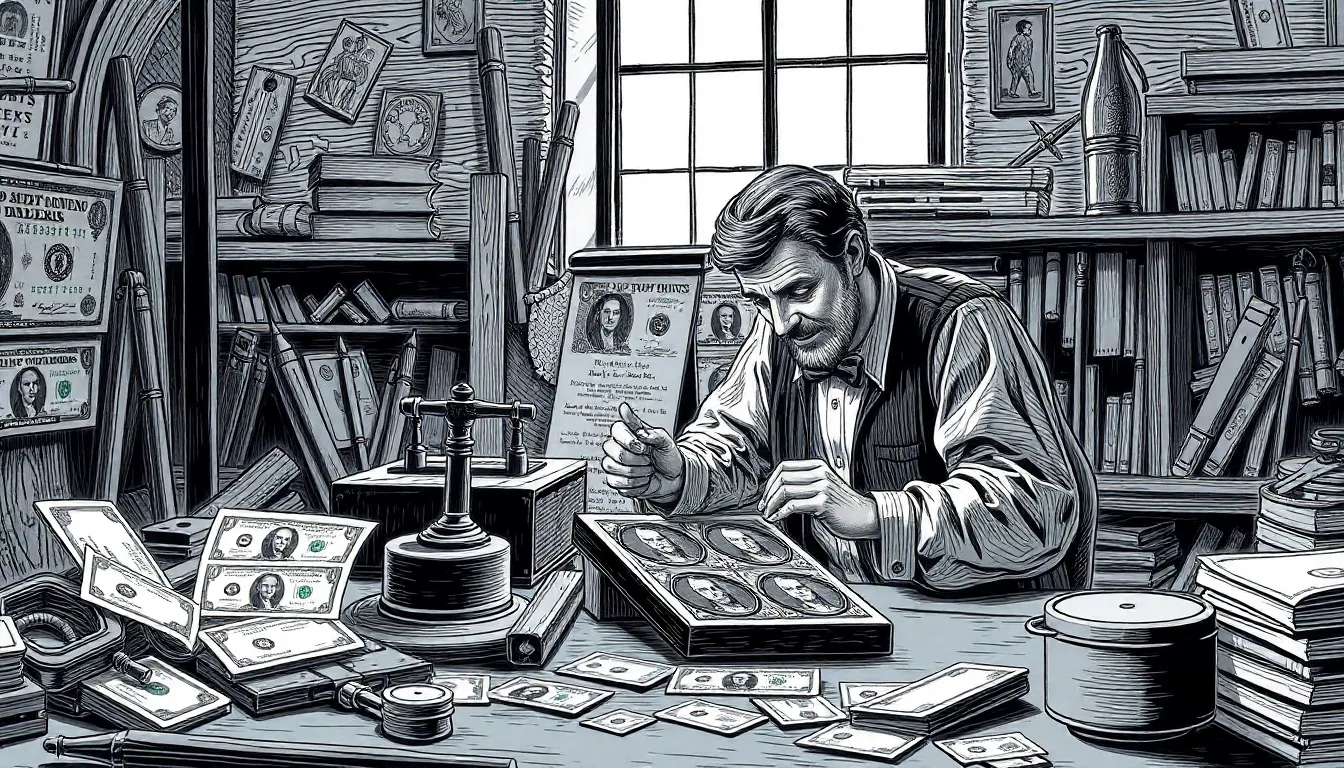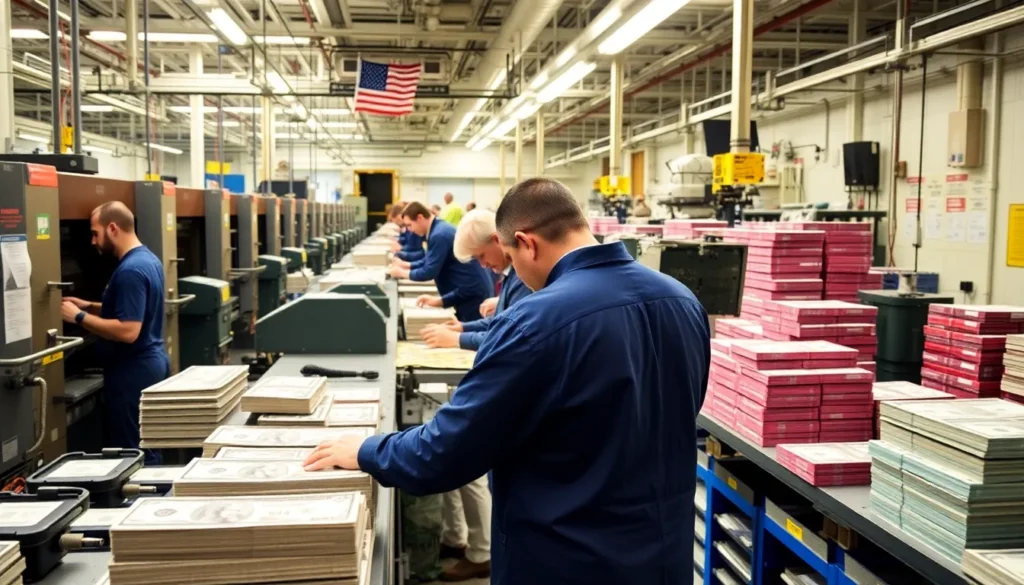Table of Contents
ToggleWhen it comes to money, most people think about cash flow, investments, or that mysterious piggy bank hiding in the closet. But have you ever wondered who’s behind the colorful bills that fuel your caffeine addiction? Enter the Bureau of Engraving and Printing, the unsung hero of the dollar bill. This isn’t just a place where paper gets a makeover; it’s where art meets finance in a spectacular way.
From intricate designs to high-tech security features, the Bureau’s work is nothing short of magical. It’s like Willy Wonka’s factory, but instead of chocolate, they whip up the currency that keeps the economy buzzing. So buckle up as we dive into the fascinating world of the Bureau of Engraving and Printing, where each note tells a story and every detail counts.
Overview of Bureau Of Engraving And Printing
The Bureau of Engraving and Printing (BEP) operates under the Department of the Treasury, focusing primarily on currency production. It specializes in both the design and manufacture of paper currency, non-currency products, and related security features. Established in 1862, it plays an essential role in the U.S. economy by ensuring an efficient and secure currency system.
Production facilities are located in Washington D.C. and Fort Worth, Texas. Currency printed in these facilities undergoes a meticulous design process, incorporating advanced technology and innovative artistry. Each banknote features unique themes and portraits, reflecting American history and values.
Security measures are vital for deterring counterfeiting. The BEP employs techniques like color-shifting inks, intricate backgrounds, and embedded security threads to protect against fraud. These features evolve continuously to counteract emerging threats.
The BEP also produces various products beyond currency. This includes treasury securities, such as savings bonds and other official government documents. Each item requires the same level of precision and attention to detail as the currency.
Public tours of the facilities offer insights into production processes and the history of currency. Visitors experience firsthand the complexity of engraving and printing operations. Educational programs enhance awareness of the BEP’s role in the economy.
Overall, the Bureau of Engraving and Printing stands as a testament to the blend of artistry and technology in the creation of currency. Its ongoing commitment to security and innovation ensures the integrity of U.S. currency.
History of Bureau Of Engraving And Printing

The Bureau of Engraving and Printing (BEP) has a rich history tied to the evolution of U.S. currency. Established in 1862, it emerged in response to the Civil War’s financial needs, aiming to efficiently produce paper money.
Founding and Early Years
Founding occurred during a period of significant economic turmoil. The need for a reliable paper currency became urgent. Initially, the BEP produced demand notes intended to finance the war. Innovations in engraving techniques enabled the creation of intricate designs. These early notes featured portraits of historical figures, aiming to instill confidence in the currency’s value. Operations began in Washington D.C., reflecting the government’s desire for centralized production of official currency.
Major Developments Through the Decades
The BEP experienced numerous developments throughout its history. In the 1920s, it adopted new printing techniques that improved efficiency and security. Implementation of offset printing in the 1930s marked a significant technological leap. This method not only enhanced the quality of banknotes but also streamlined production processes. Security features evolved over the decades, incorporating advancements such as watermarks and color-shifting inks. The introduction of the modern $1 bill in 1963 showcased these improvements, blending artistry with cutting-edge technology.
Current Operations and Services
The Bureau of Engraving and Printing (BEP) engages in various operations focused on currency production and security. Its ongoing commitment to high-quality craftsmanship underpins every service provided.
Currency Production Process
The currency production process at the BEP begins with meticulous design layouts that reflect American heritage. Artists create intricate engravings, ensuring each banknote tells a story. Advanced technology, including high-speed printing presses, enhances efficiency and quality. Production facilities in Washington D.C. and Fort Worth, Texas employ around 2,000 skilled workers. These personnel ensure that currency meets rigorous standards before it’s issued. Each printing cycle produces millions of banknotes, which undergo strict quality control measures before distribution.
Security Features Incorporated
The BEP continually innovates security features to combat counterfeiting. Specialized inks and printing techniques create visually complex designs that are difficult to replicate. Features like color-shifting ink, watermarks, and micro-printing enhance the security profile of each banknote. In addition to traditional measures, advanced technology incorporates security threads and UV features. Each newly issued bill integrates the latest advancements in security, guarding against emerging counterfeiting threats. Continuous assessment guarantees that security features remain effective and up to date.
Visitor Experience at Bureau Of Engraving And Printing
Visitors enjoy an engaging experience at the Bureau of Engraving and Printing, highlighted by interactive tours and educational programs that dive into the intricacies of currency production.
Tour Options and Educational Programs
Guided tours offer insights into the production process, with knowledgeable staff members sharing fascinating facts about engraving and printing. Daily tours operate at designated times, accommodating visitors with varying schedules. Group tours are available, making it easy for schools and organizations to explore the art and technology of U.S. currency. Special programs cater to students and educators, emphasizing the significance of financial literacy. These programs inspire understanding of money’s history and impact within the economy, contributing to informed citizens.
Exhibits and Displays
Exhibits showcase the evolution of currency design, featuring artifacts and interactive displays that captivate audiences. Artistry is evident in the intricate designs and security features of banknotes displayed in the visitor center. Multi-sensory experiences enhance visitor engagement, allowing individuals to learn through hands-on exhibits. Historical information enriches the context of currency, making it accessible and relevant. A gift shop offers unique currency-themed souvenirs, providing a lasting reminder of their visit.
Challenges Facing the Bureau Of Engraving And Printing
The Bureau of Engraving and Printing (BEP) faces several challenges that impact its operations and security measures. Budget constraints significantly limit the BEP’s ability to adopt new technologies and enhance production capabilities. Counterfeit currency poses a constant threat, requiring the BEP to innovate continuously to outpace criminals who exploit advances in printing technology.
A shortage of skilled labor affects the quality of craftsmanship that the BEP prides itself on. As experienced engravers retire, recruiting and training new talent becomes increasingly vital. Aging production facilities in Washington D.C. necessitate upgrades, which demand substantial investment to maintain security and efficiency.
Moreover, adapting to rapidly changing technology remains a significant challenge. Digital advancements in financial transactions reduce the reliance on physical cash, impacting demand for printed currency. Concerns over cybersecurity add another layer of complexity, as protecting sensitive information becomes critical in an evolving digital landscape.
Public perception also influences the BEP’s operations. Educating the public about the importance of proper currency design and security features is essential in combating misinformation. As financial literacy declines, the BEP must focus on outreach programs to inform citizens about the value of secure currency.
The challenges facing the BEP encompass budget limitations, workforce issues, technological adaptation, and public education. Maintaining high production standards while addressing these hurdles remains crucial for the integrity and future of U.S. currency.
The Bureau of Engraving and Printing plays a vital role in the U.S. economy by ensuring the integrity and security of currency. Its blend of artistry and technology not only produces banknotes but also reflects American heritage and values. Through continuous innovation and rigorous quality control, the BEP adapts to evolving challenges in currency production and counterfeiting.
Public engagement through tours and educational programs fosters an appreciation for the complexities of currency design. As the BEP navigates budget constraints and technological advancements, its commitment to producing high-quality currency remains steadfast. The future of U.S. currency lies in the hands of this institution as it continues to safeguard the nation’s financial system.







